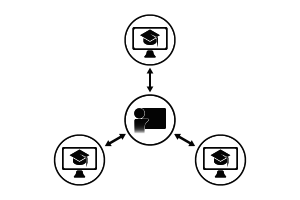Establishing Presence: Quick Tips

“The importance of creating a sense of presence in online teaching and learning environments cannot be overestimated.” –– Lehman and Conceição, 2010, p. viii
 The degree to which students in an online course feel connected to one another, to their instructor, and to the course content profoundly influences their satisfaction and success in the course. Establishing this sense of connection, called “presence,” is a central feature of effective online teaching.
The degree to which students in an online course feel connected to one another, to their instructor, and to the course content profoundly influences their satisfaction and success in the course. Establishing this sense of connection, called “presence,” is a central feature of effective online teaching.
You can establish presence by breaking down the distance between yourself and your students, adding personal dimensions to your course, and encouraging students to connect with one another.
There are many possible strategies and approaches for building a sense of presence. Here are just a few.
Strategies for Establishing Presence
Introductory video
Create a video to introduce yourself and your course to students. Make it personal enough to give them a sense of who you are.
Example: In an introductory video, an engineering faculty member talks about how her love of math came from the brainteasers her father used to give her at the dinner table during her childhood in Belgrade.
Introductory survey
Send out a short survey at the beginning of the semester to collect information about your students that will help you get to know them better.
Example: A marketing professor sends out a survey asking his students (who are all over the world) about their work experience, their undergraduate majors, and what they know about marketing and marketers.
Icebreaking exercises
In the first week of class, assign a fun exercise related to the course material to help students get to know one another.
Example: The instructor of a professional development course for university faculty members asks her students to take the Teaching Perspectives Inventory, post their profiles, and compare notes with colleagues in an online discussion board.
Audio or video announcements
When you make announcements to your class, consider doing them as short videos or podcasts so that students can attach a face or voice to the message.
Example: An anthropology professor sends out weekly video announcements to her students. She likes to record them at her home, surrounded by artifacts from her fieldwork in Micronesia.
Student bios
Ask students to introduce themselves to the class using a creative presentation that they post on a designated discussion board.
Example: The instructor of a course in the decision sciences asks students to introduce themselves and write about the best or worst decision they ever made. She uses their responses as a springboard for introducing course content.
Regular communication
Maintain regular contact with your class through weekly e-mails or announcements. Remind students about deadlines, offer help, and share resources.
Example: An environmental engineering professor gives students a bonus point for finding articles in the popular press that relate to the environmental issues they’re studying. Every week, he collects the links and sends them out to the entire class.
Group identity
When assigning group projects, encourage groups to choose a name. Cultivate a sense of group identity and solidarity.
Example: The instructor of a course in computer engineering puts students into permanent groups in which they work on developing fast code. Every week, he runs all the groups’ programs and publicly congratulates the team with the fastest code.
Personalization
Look for opportunities to individualize course materials and imbue them with your own style and personality.
Example: A computer science instructor delivering a video lecture about cookies (the digital kind) adds some levity by pulling out a chocolate chip cookie and a mug of coffee as he finishes his presentation.
Permanent discussion groups
Consider putting students into small discussion groups for the entire semester to promote bonding.
Example: The instructor of a management class divides her 60-person class into groups of 10 to discuss case studies. The members of these small groups get to know one another well over the course of the semester.
Friendly tone in course documents
Use a relaxed, conversational tone in your course overview and other documents.
Example: When translating his face-to-face European history course to the online environment, the instructor intentionally changes the formal tone of all his course documents to reduce the distance between himself and his students.
Individual contact
If your class isn’t too large, think about contacting each student individually to say hello, welcome him or her to the course, and get acquainted.
Example: A marketing professor places a 10- to 15-minute call to every student a week before classes begin. In these phone calls, he tells students about himself, clarifies his expectations, and asks them what they hope to get out of the course. He uses what he learns about his students to create teams.
Establishing presence in your online course is not as difficult as you might think! The lack of face-to-face interaction doesn’t have to be a hindrance. You can use audiovisual tools to facilitate introductions and encourage familiarity among your students. Along those lines, form student groups for assignments and discussions. Don’t be afraid to personalize course materials and use humor or a more informal tone to put students at ease. Communicate with your students on a regular basis––whether through class announcements or individualized contact––to let them know you’re there. These are just a few of the strategies you can use to develop a sense of connection with and among your online students.
References
Lehman, R. M., & Conceição, S. C. O. (2010). Creating a sense of presence in online teaching: How to “be there” for distance learners. San Francisco, CA: Jossey-Bass.
